During the Jurassic and probably parts of the Cretaceous, marine conditions prevailed in Northern Switzerland (Mazurek & de Haller 2017). The δ18O values of calcite-forming fluids (obtained from clumped isotope thermometry, see Section 4.3.5) in the Mesozoic strata for this period are mostly around 0 ‰ VSMOW or even slightly above (Fig. 4‑129). They can be interpreted as remnants of old formation water that evolved from the original seawater by interaction with the rock in the course of geological history. The slightly negative δ18O values of some early-diagenetic phases in the Lias Group may evidence localised, short-term emergence (Section 4.2.5; see also Reisdorf & Wetzel 2018).
In the Late Eocene, at around 52 Ma, the δ18O values of calcite-forming fluids started to evolve towards meteoric signatures, reaching -4 to -5 ‰ VSMOW during the Oligocene – Early Miocene times (Fig. 4‑129 and Fig. 4‑130a). This trend resulted from subaerial exposure since at least Eocene times (Chapter 3, Section 4.3.5; Schegg & Leu 1998, Mazurek et al. 2006), which led to karstification in the top of the Malm Group, deposition of the Bohnerz Formation (Siderolithic Group) and, ultimately, direct recharge and in-diffusion of meteoric water into the Mesozoic strata. Continental conditions persisted throughout the Oligocene and downward migration of meteoric water into the Mesozoic strata continued. Surficial freshwater for this time period showed δ18O values (based on fossil bone and tooth apatite of vertebrates; Tütken et al. 2006, Tütken & Vennemann 2009, Héran et al. 2010, Tütken 2014, Tütken & Absolon 2015, Ring et al. 2020) that are in good agreement with those of the calcite-forming fluids observed in the Malm Group and the Dogger Group above Opalinus Clay.
Samples from the clay pit in Frick (Fig. 4‑60) show meteoric δ18O values in the Staffelegg Formation at 21 – 34 Ma (Fig. 4‑130b). The processes by which the meteoric signals were transported to these levels of the strata are not yet fully understood. However, the Cenozoic evolution of the Frick area differs from the siting regions in the sense that Molasse deposits were substantially thinner. Whether this is due to non-deposition or due to OMM to post-OMM erosion remains unclear (Diebold et al. 2006). The erosional event removed not only possible older Molasse deposits but also locally Mesozoic units down to the Dogger Group (Diebold et al. 2006). That is, there were probably prolonged meteoric conditions, and the relevant overburden thickness was substantially thinner, resulting in a more direct transmission of meteoric signals. Furthermore, the relative proximity to the Upper Rhine Graben (Section 4.3.3) could have had an influence on vertical fluid flow by the formation of normal faults at that time. Based on the aforementioned reasons, these samples from Frick are not necessarily representative for the palaeohydrogeological evolution of the siting regions.
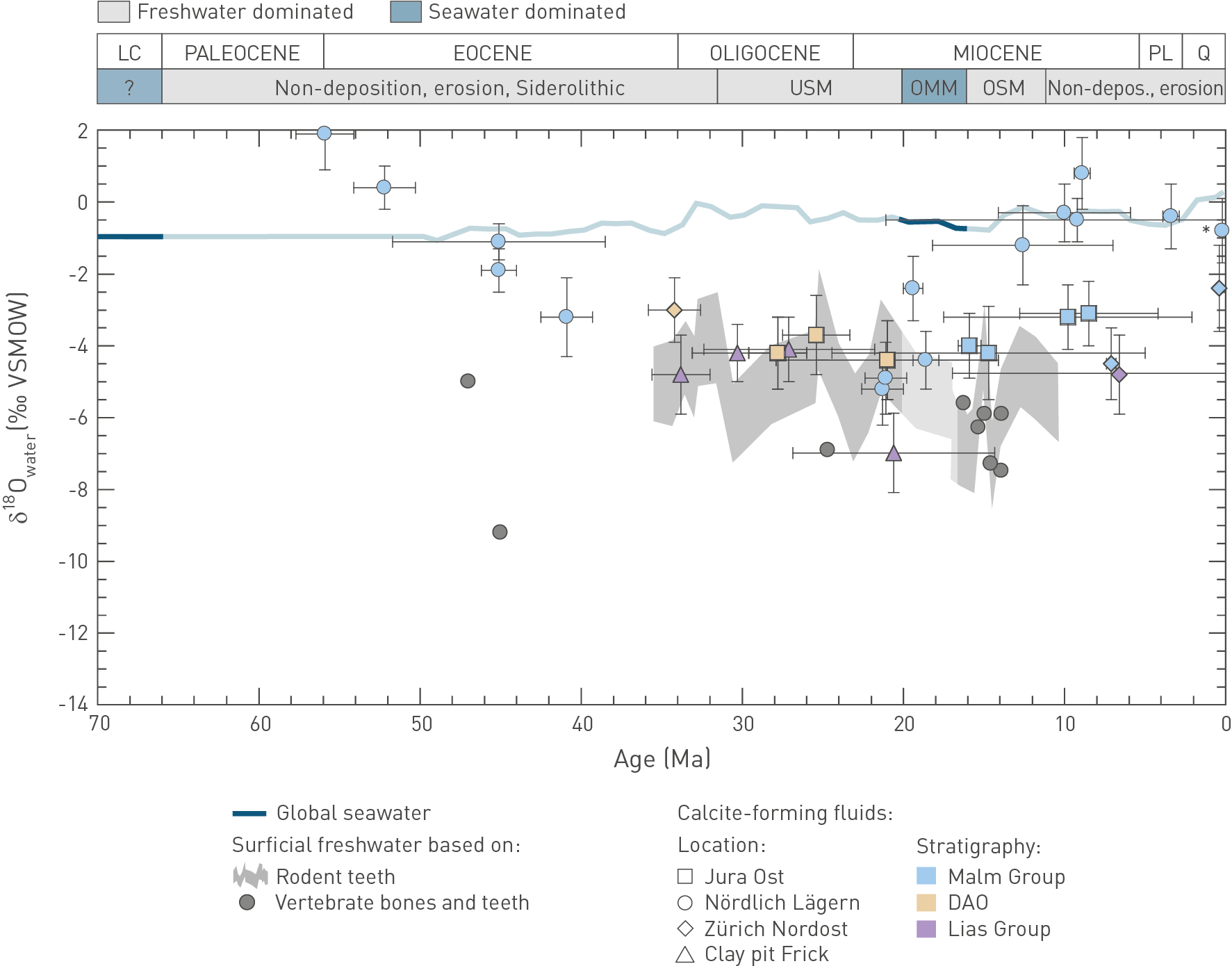
Fig. 4‑129:Evolution of δ18O of calcite-forming fluids over the last 70 Ma as obtained from coupled clumped isotope thermometry and U-Pb and U-Th dating of calcite cements
For comparison, literature data for seawater (Lear et al. 2000) and Eocene – Miocene surficial freshwater are also shown Tütken et al. 2006, Tütken & Vennemann 2009, Héran et al. 2010, Tütken 2014, Tütken & Absolon 2015, Ring et al. 2020. As a result of consistently low U concentrations and high Pb contents (dominated by common Pb), no reliable U-Pb age data could be obtained for vein calcite in the Opalinus Clay (Akker et al. 2023). Data for the Lias at the Frick clay pit are from Looser (2022). Q: Quaternary, PL: Pliocene, LC: Late Cretaceous, DAO: Dogger Group above Opalinus Clay. Post-kinematic calcite (see text for details). Data of regional fault-related outcrops in the Eastern Jura (see Fig. 4‑73) are not shown here because they are not considered representative for the fluid evolution in the comparably weakly deformed and deeply buried Mesozoic strata in the siting regions.
For the siting regions, the earliest occurrence of meteoric waters in the Lias Group is indicated by a vein in ZNO dated to 7 Ma (although the uncertainty on the age is large). The calcite-forming fluid shows similar negative δ18O values as observed for the Dogger Group above Opalinus Clay (ZNO and JO) during the Oligocene. Thus, for the hydrogeological evolution of the Opalinus Clay in the siting regions, an influence of meteoric waters is indicated latest by Late Miocene times.
For the Malm Group, a large variability in δ18O values is indicated for the Miocene Epoch (Fig. 4‑129). This variability is interpreted to result from:
-
Downward migration of seawater during the Burdigalian marine transgression and deposi- tion of the Upper Marine Molasse Group (OMM) at around 16 – 20 Ma (Garefalakis & Schlunegger 2019; Chapter 3), which interrupted Miocene freshwater-dominated conditions. This is also evidenced by distinct trends of upwards decreasing δ13C and increasing 87Sr/86Sr values from vein calcite in the top of the Malm Group at the Oftringen borehole (see also de Haller et al. 2011 and for the NL boreholes Fig. 4‑132 and Fig. 4‑133).
-
After deposition of the OMM, freshwater-dominated conditions were re-established and meteoric water migrated into the Mesozoic strata. The Molasse deposits are relatively thin in JO (ca. 100 m in total), whereas in NL they reach a thickness of more than 400 m. For the latter siting region this results in higher burial temperatures (50 – 80 °C in NL vs. 45 – 60 °C in JO for the Malm Group) and longer transport distances, i.e. potentially longer subsurface residence time of the calcite-forming fluids during which their isotope composition is modified by the interaction with the rock.
For two of the veins in the Malm Group, U-Th geochronology yields Pleistocene ages. The corresponding vein calcite from ZNO (Villigen Formation, TRU1-1) is synkinematic, collected from a strike-slip fault that formed in response to contraction (Section 4.3.4). In contrast, the vein calcite from NL («Felsenkalke» and «Massenkalk», STA3-1) is post-kinematic, i.e. reflecting a fluid pulse with no concurrent deformation. The mineral-forming fluids of these two young vein calcites show the same difference in their δ18O values as observed for Miocene times, i.e. with seawater-type δ18O values in NL and distinctly more negative values in ZNO. Similarly, as explained above, variation in subsurface residence times, transport distances and burial temperatures can explain the difference in the δ18O values of the calcite-forming fluids between the siting regions. Also, the groundwater in the Malm aquifer can play a role: At least for the vein from the Villigen Formation in ZNO (0.4 Ma; Fig. 4‑130), a transient hydraulic connection with the Malm groundwater (i.e. as sampled at present) is evident. This is indicated by a distinct shift of the calcite-forming fluid towards a more positive δ18O value (in good agreement with those of the groundwater) relative to the present-day porewater in the adjacent rock.
As observed for the confining units, calcite-forming fluids in the Opalinus Clay show a large variability in their δ18O signatures ranging from modified seawater-type to distinctly negative values (Fig. 4‑130e). The consistently low U concentrations and the high Pb contents of the vein calcites dominated by common Pb (Akker et al. 2023) result in no reliable U-Pb age data being obtained (except for two Jurassic ages; Fig. 4‑73) that would help to better constrain the evolution of the calcite-forming fluids. Following the above observations for the confining units, i.e. involving a transition from modified seawater-type to meteoric δ18O values during Eocene – Oligocene times, it is argued that the variability observed for the calcite-forming fluids in the Opalinus Clay reflects a similar evolution. Based on the temperature – depth history of the Mesozoic strata (Mazurek et al. 2006, Looser 2022; Section 4.3.5), the temperatures of vein formation of 57 – 102 °C for the modified seawater-type (Paleocene and older) and 50 – 81 °C for the meteoric waters (Eocene and younger) are consistent with such a hypothesis. This is illustrated in Fig. 4‑131a, which shows the temperature and δ18O values of calcite-forming fluids together with the timing of precipitation in veins of the confining units. Hence, for the Opalinus Clay, vein formation during Late Jurassic - Cretaceous, as well as later during Eocene – Miocene times, is indicated. Note that all calcite-forming fluids in the Opalinus Clay show less negative δ18O values and/or higher temperatures compared to the present-day porewater in the adjacent rock matrix (Fig. 4‑131b), suggesting that vein formation occurred before Pliocene cooling started at around 5 Ma (Section 4.3.5), i.e. beyond the memory window estimated for the porewater δ18O profiles (Section 4.6.2).
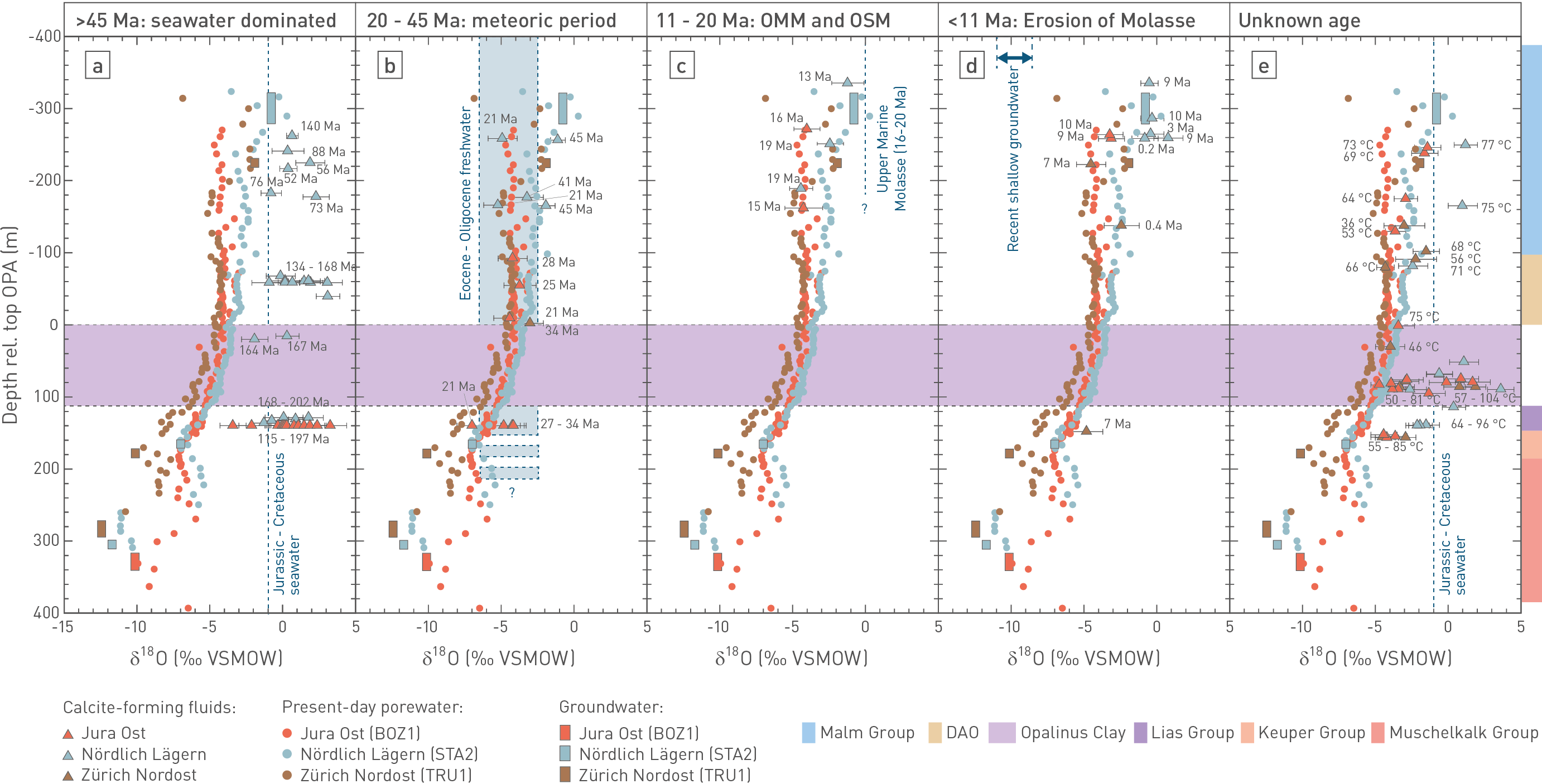
Fig. 4‑130:Depth profiles of the oxygen isotope composition of calcite-forming fluids derived from clumped isotope thermometry for different time periods
Depths are relative to the top of the Opalinus Clay. For comparison, the oxygen isotope composition of the present-day porewater is also illustrated (Section 4.6), as well as the values for the groundwater in the confining aquifers (Section 4.5.5). The numbers indicate U-Pb/Th ages or clumped isotope temperatures for structures with no reliable age data. a) Time period for which calcite-forming fluids constitute remnants of old formation water that evolved from the original seawater by interaction with the rock. b) Time period during which meteoric waters migrated into the Mesozoic strata before deposition of the Upper Marine Molasse Group (OMM). c) Situation during deposition of the OMM and the Upper Freshwater Molasse (OSM) Groups. d) Situation after Molasse deposition. e) Samples with no reliable age data.
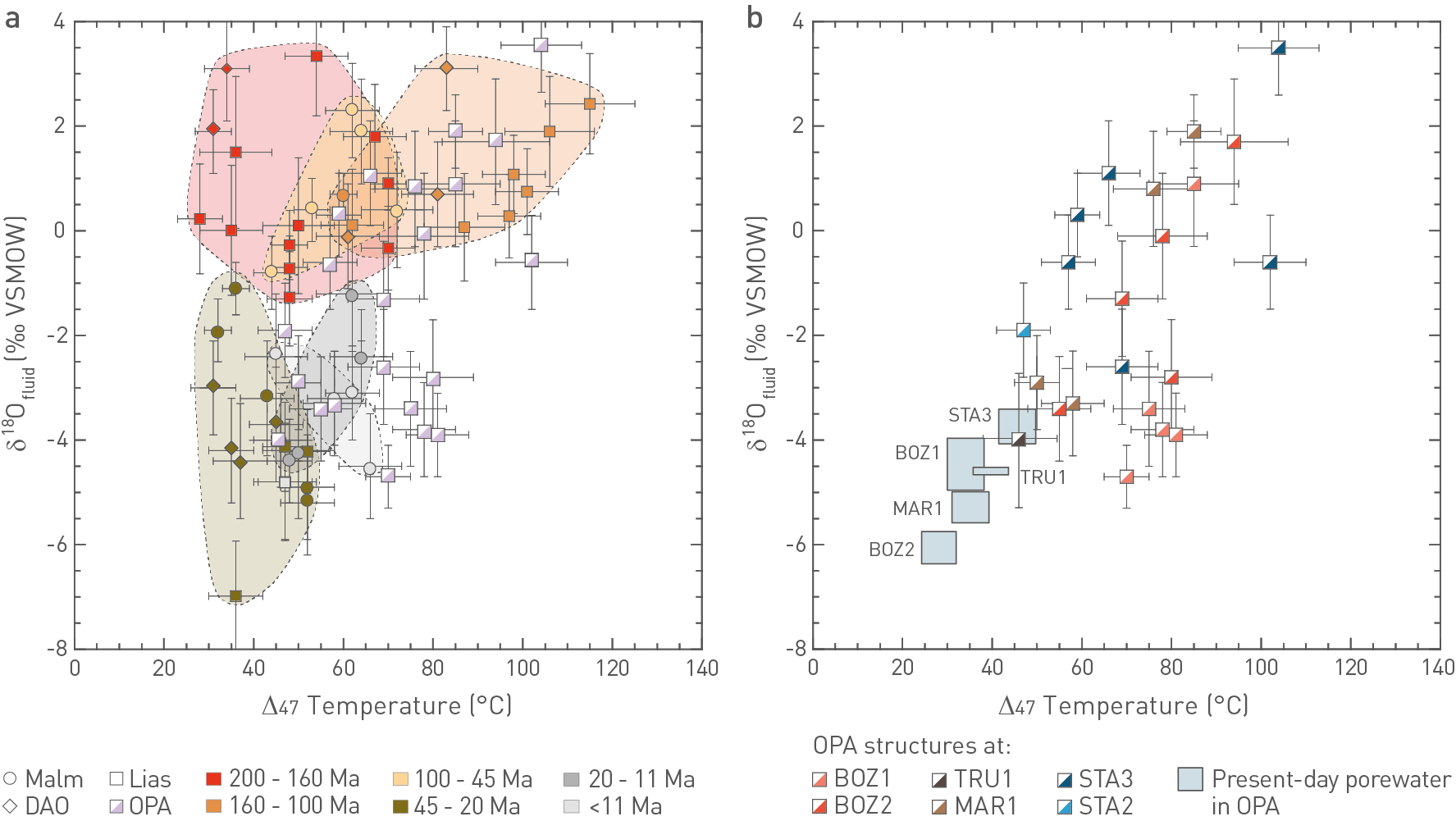
Fig. 4‑131:Temperature and δ18O values of calcite-forming fluids from clumped isotope thermometry
a) The coloured fields indicate the timing of vein formation in the units above and below the Opalinus Clay (based on U-Pb geochronology) to better constrain the timing of vein formation in the Opalinus Clay (no reliable U-Pb data; see text). Calcite-forming fluids from the Malm affected by relatively shallow, near-surface processes (e.g. downward migration of OMM seawater) are not shown in this graph (see Section 4.7.6). b) Calcite-forming fluids in the Opalinus Clay compared to the δ18O values and temperatures of the present-day porewater in the adjacent rock matrix. DAO: Dogger Group above Opalinus Clay, OPA: Opalinus Clay.
Regarding the δ13C of vein calcite, the Opalinus Clay generally shows similar values to the matrix carbonate (except for JO; see below), but at lower levels compared to the Malm Group (Fig. 4‑132). This difference probably reflects the relatively higher content of organic material in the clay-mineral-rich lithologies (e.g. Nagra (ed.) 2021a, Dossier VIII), which provides a source for isotopically light carbon. Thus, an internal evolution of the calcite-forming fluids is conceivable for the Opalinus Clay. However, the coherence of δ13C of veins and rock matrix is a necessary but not a sufficient argument. Fracture apertures in the clay-mineral-rich lithologies are generally very narrow and potential fluid fluxes were supposedly low; thus, rock buffering is considered very effective, and any external carbon isotope signal could be obliterated by the interaction with the rock (see Section 4.7.2). Vein calcite in the Opalinus Clay in JO is somewhat exceptional because δ13C values of vein calcite and matrix carbonate are clearly different, with the former showing distinctly more negative values. The reason for this is yet to be resolved. Potentially, it reflects an external signal, but it could also result from, for instance, the decomposition of organic material (Harrison et al. 2022), similarly to what was suggested for the very negative δ13C values of early diagenetic calcite in the underlying Staffelegg Formation.
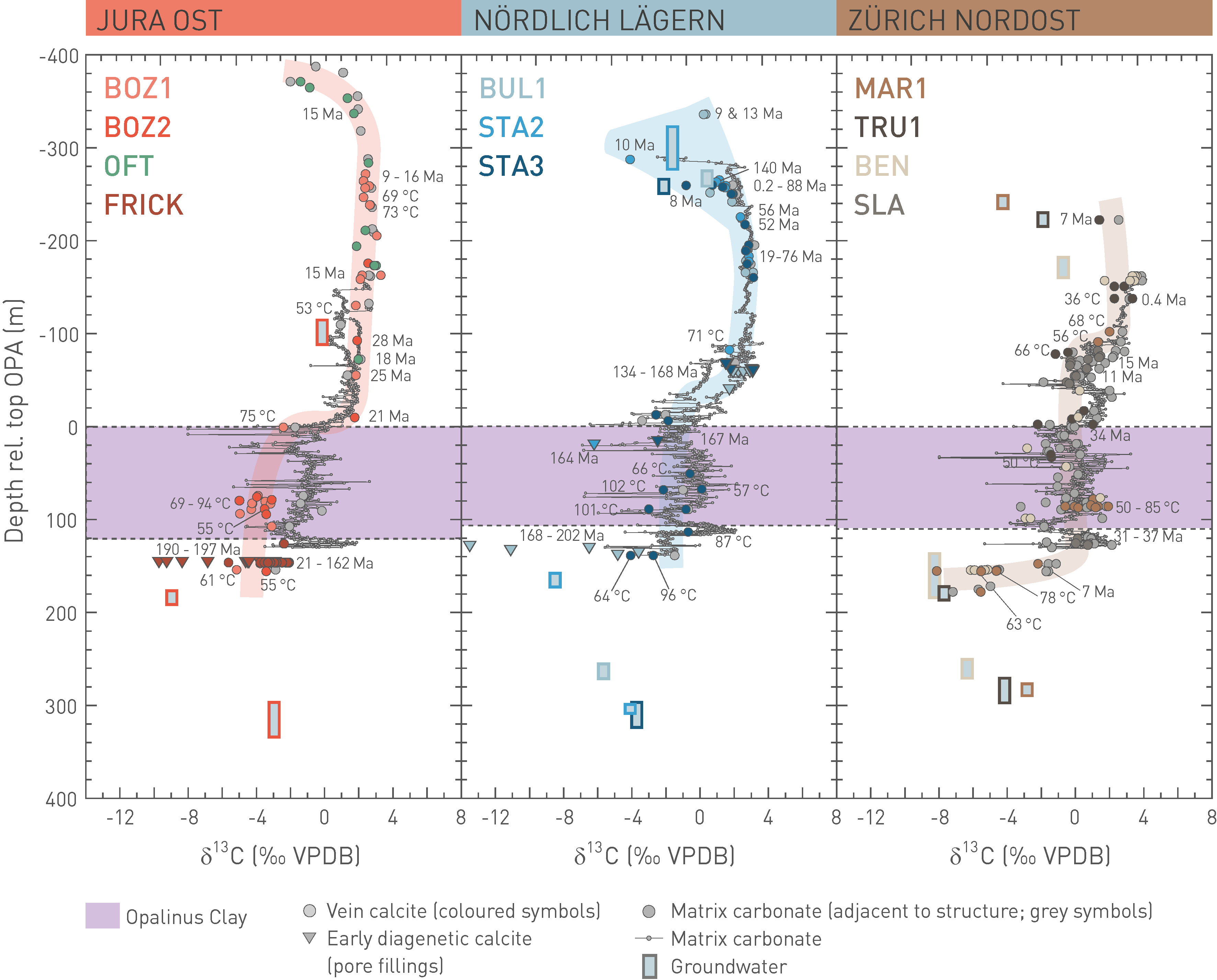
Fig. 4‑132:Depth profiles of the carbon isotope composition of vein calcite and matrix carbonate
Depths are relative to the top of the Opalinus Clay. For comparison, the carbon isotope composition of the groundwater samples is also shown. The black numbers indicate U-Pb ages (Ma) or clumped isotope temperatures (°C) for samples with no reliable U-Pb age. The coloured fields highlight the trends observed for vein calcite. Data for the older Benken (BEN), Oftringen (OFT) and Schlattingen (SLA) boreholes are from Nagra (2001), de Haller et al. (2011) and Mazurek et al. (2018). The data from the clay pit of Frick are from Looser (2022). Note that the OFT data are illustrated in the JO plot although the borehole is located ca. 27 km southwest of the siting region. Matrix carbonate composition based on Ruf et al. (2005), Nagra (ed.) 2023a, Dossier IV) and Wohlwend et al. (2024). OPA: Opalinus Clay.
In the Opalinus Clay, 87Sr/86Sr ratios of vein calcite and celestite are all higher compared to the overlying more calcareous lithologies (Fig. 4‑133; except for the top of the Malm Group where downward migration of Burdigalian seawater is evident). Also, 87Sr/86Sr ratios of vein calcite are higher compared to the matrix carbonate. This implies that the mineral-forming fluids in the Opalinus Clay evolved within rubidium-bearing lithologies where they picked up radiogenic strontium from continuous rubidium decay. An evident source for radiogenic strontium is the rubidium associated with clay minerals. As for the carbon isotopes, an internal evolution of the mineral-forming fluids is conceivable for the Opalinus Clay (bulk rock 87Sr/86Sr ratios up to 0.714052; Nagra 2001) but again this could also simply attest to an effective rock buffering (see Section 4.7.2).
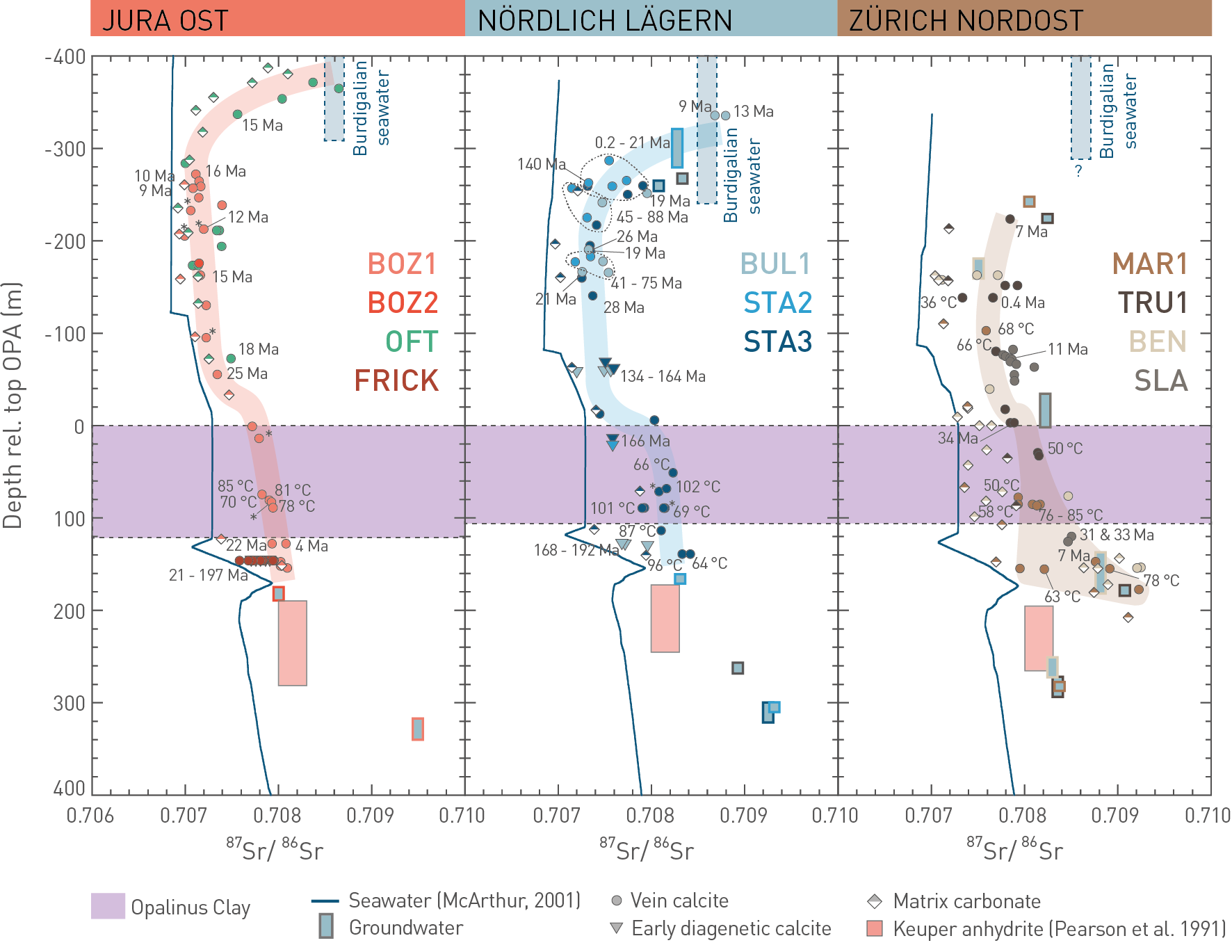
Fig. 4‑133:Depth profiles of strontium isotope ratios of vein calcite, vein celestite and present-day porewater
Depths are relative to the top of the Opalinus Clay. For comparison, the palaeo-seawater line is also illustrated (McArthur et al. 2001), as well as the present-day groundwater in the confining aquifers (Section 4.5.5) and Keuper anhydrite (Pearson et al. 1991). The black numbers indicate U-Pb ages (Ma) or clumped isotope temperatures (°C) for samples with no reliable U-Pb age. The coloured fields describe the general trends observed for the mineral-forming fluids (see text for details). Data for the Benken (BEN), Oftringen (OFT) and Schlattingen (SLA) boreholes are from Nagra (2001), de Haller et al. (2011) and Mazurek et al. (2018). The data from the clay pit of Frick are from Looser (2022). Note that the OFT data are illustrated in the JO plot although the borehole is located around 27 km southwest of the siting region. OPA: Opalinus Clay. Samples marked with an asterisk refer to vein celestite.

